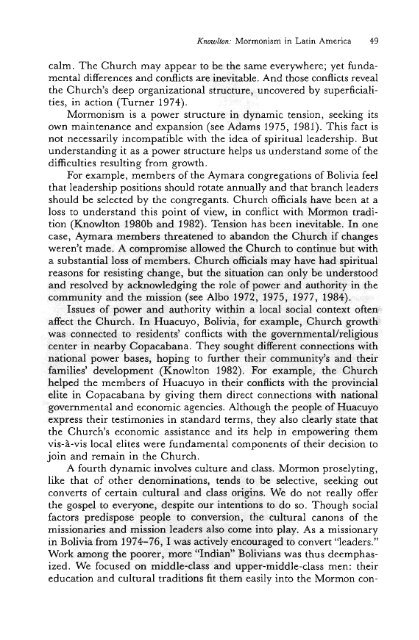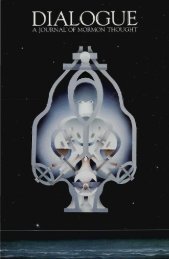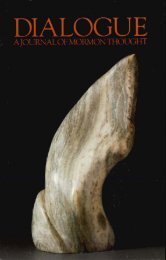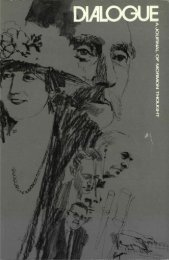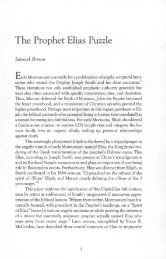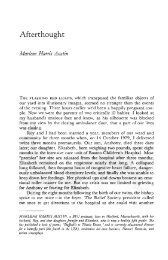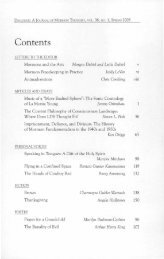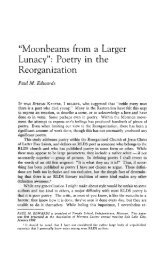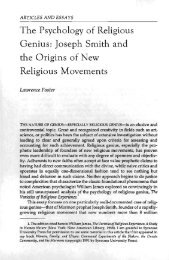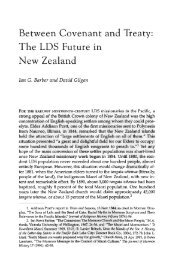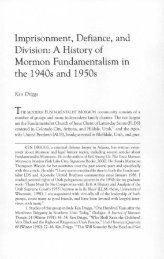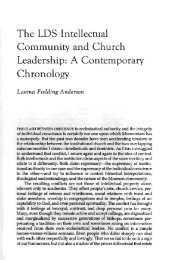Dialogue, Volume 25, Number 2 - Dialogue – A Journal of Mormon ...
Dialogue, Volume 25, Number 2 - Dialogue – A Journal of Mormon ...
Dialogue, Volume 25, Number 2 - Dialogue – A Journal of Mormon ...
You also want an ePaper? Increase the reach of your titles
YUMPU automatically turns print PDFs into web optimized ePapers that Google loves.
Knowlton: <strong>Mormon</strong>ism in Latin America 49<br />
calm. The Church may appear to be the same everywhere; yet fundamental<br />
differences and conflicts are inevitable. And those conflicts reveal<br />
the Church's deep organizational structure, uncovered by superficialities,<br />
in action (Turner 1974).<br />
<strong>Mormon</strong>ism is a power structure in dynamic tension, seeking its<br />
own maintenance and expansion (see Adams 1975, 1981). This fact is<br />
not necessarily incompatible with the idea <strong>of</strong> spiritual leadership. But<br />
understanding it as a power structure helps us understand some <strong>of</strong> the<br />
difficulties resulting from growth.<br />
For example, members <strong>of</strong> the Aymara congregations <strong>of</strong> Bolivia feel<br />
that leadership positions should rotate annually and that branch leaders<br />
should be selected by the congregants. Church <strong>of</strong>ficials have been at a<br />
loss to understand this point <strong>of</strong> view, in conflict with <strong>Mormon</strong> tradition<br />
(Knowlton 1980b and 1982). Tension has been inevitable. In one<br />
case, Aymara members threatened to abandon the Church if changes<br />
weren't made. A compromise allowed the Church to continue but with<br />
a substantial loss <strong>of</strong> members. Church <strong>of</strong>ficials may have had spiritual<br />
reasons for resisting change, but the situation can only be understood<br />
and resolved by acknowledging the role <strong>of</strong> power and authority in the<br />
community and the mission (see Albo 1972, 1975, 1977, 1984).<br />
Issues <strong>of</strong> power and authority within a local social context <strong>of</strong>ten<br />
affect the Church. In Huacuyo, Bolivia, for example, Church growth<br />
was connected to residents' conflicts with the governmental/religious<br />
center in nearby Copacabana. They sought different connections with<br />
national power bases, hoping to further their community's and their<br />
families' development (Knowlton 1982). For example, the Church<br />
helped the members <strong>of</strong> Huacuyo in their conflicts with the provincial<br />
elite in Copacabana by giving them direct connections with national<br />
governmental and economic agencies. Although the people <strong>of</strong> Huacuyo<br />
express their testimonies in standard terms, they also clearly state that<br />
the Church's economic assistance and its help in empowering them<br />
vis-a-vis local elites were fundamental components <strong>of</strong> their decision to<br />
join and remain in the Church.<br />
A fourth dynamic involves culture and class. <strong>Mormon</strong> proselyting,<br />
like that <strong>of</strong> other denominations, tends to be selective, seeking out<br />
converts <strong>of</strong> certain cultural and class origins. We do not really <strong>of</strong>fer<br />
the gospel to everyone, despite our intentions to do so. Though social<br />
factors predispose people to conversion, the cultural canons <strong>of</strong> the<br />
missionaries and mission leaders also come into play. As a missionary<br />
in Bolivia from 1974-76, I was actively encouraged to convert "leaders."<br />
Work among the poorer, more "Indian" Bolivians was thus deemphasized.<br />
We focused on middle-class and upper-middle-class men: their<br />
education and cultural traditions fit them easily into the <strong>Mormon</strong> con-


